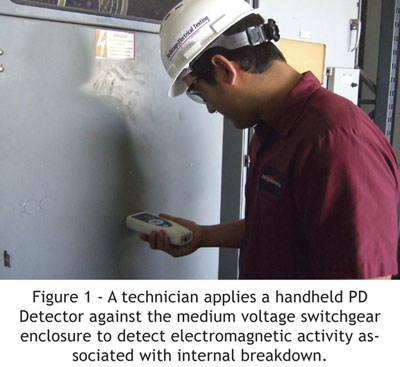Visual Inspections are very useful but may be limited due to equipment construction. However, it is always recommended to conduct thorough visual inspections in conjunction with any of the other ‘no-outage’ technologies. Visual inspections may indicate unusual conditions that other technologies may not directly detect.
Infrared (IR) technology is primarily used to detect conductor problems and can be useful for inspecting any equipment where connections are visible. It is important to realize that insulation problems rarely create a detectable temperature rise, so other technologies should also be employed. IR is probably the best on-line tool for detecting low voltage problems.
Partial discharge (PD) testing using electromagnetic signal detection is very useful in identifying problems within switchgear, cables, dry-type transformers and other devices. PD testing is not as effective as Airborne Acoustic or Corona Camera surveys when inspecting “open” constructed equipment. A new handheld PD detector (shown in Figure 1) has been developed that combines ultrasonic and electromagnetic sensor technologies into one easy-to-use instrument which allows medium voltage insulation to be surveyed for defects in an efficient and cost-effective manner.

Airborne Acoustic (AA) or ultrasonic listening can be useful in detecting direct line-of-sight surface insulation problems or when the acoustic signal escapes the equipment enclosure through openings. One advantage of using ultrasonic inspections is that surveys can be conducted quickly.
The Corona Camera detects direct line-of-sight surface insulation or conductor problems very effectively by producing an image of the problem that is normally invisible during daylight conditions. This technology is perhaps the best for outdoor substations or high voltage applications, but also supplements the other no-outage technologies by providing visual proof of surface problems. Just as every apparatus with connections should be scanned with IR, all medium & high voltage equipment should be scanned for Corona.
Oil/Gas sampling and analysis is an effective tool to indicate both the condition of the insulation and the condition of the equipment. Unfortunately, solid insulation cannot be sampled in the same manner, so other on-line technologies must be employed to evaluate equipment constructed with solid dielectrics.
Comparing the No-Outage Technologies
Remember the old saying – “a picture is worth a thousand words”? Below we will display the differences in some of these technologies pictorially to better help identify their differences.
First, we should briefly explain the differences between two popular inspection methods, infrared and partial discharge technologies. Infrared technology detects heat that is generated by current flow or amperage related problems that are often caused by loose connections. So, infrared detects the condition of the conductor. Partial discharge, ultrasonic and corona surveys detect voltage problems that occur from the partial failure of the insulation. So, these technologies detect the condition of the insulation. In order for partial discharges or corona to occur, typically voltages greater than 2,000 volts must be present. Therefore, these technologies are not effective for low voltage applications.
Now, back to the pictures. We created simple, surface discharges in the laboratory by applying an AC hypot to an unshielded medium voltage conductor that was placed upon a ground conductor. We then performed several types of tests as shown in Figures 2-6.





What conclusions can be made from this simple experiment and our previous knowledge of these technologies?
• Infrared is the best tool for low voltage equipment assessment. This should be a “minimum” annual test requirement, especially for low voltage equipment.
• For medium voltage switchgear and dry-type transformers that have surface tracking or corona problems, the Ultrasonic tester provides a quick and relatively inexpensive solution that will detect many problems.
• A Partial Discharge test set using a capacitive sensor can detect “deep” or non-surface insulation defects in medium voltage switchgear and dry-type transformers and should be used to supplement the ultrasonic test set in order to detect additional problems.
• A Partial Discharge test set using a high frequency current transformer is the best tool to detect cable, termination and splice problems
• A Daylight Corona camera is excellent for pinpointing surface discharges in medium voltage equipment and is the best tool for high voltage equipment
Conclusion
So what is the “best” No-Outage technology? The answer is the one that will detect the problem. While none of the technologies discussed in this article can single-handedly detect every type of problem, by employing all of these technologies as part of an annual predictive maintenance program, many problems will be detected and many failures will be prevented. The matrix shown in Figure 7 has been created to help identify the best “No-Outage” technologies available for various types of electrical equipment.


